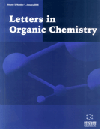- Home
- A-Z Publications
- Letters in Organic Chemistry
- Previous Issues
- Volume 20, Issue 1, 2023
Letters in Organic Chemistry - Volume 20, Issue 1, 2023
Volume 20, Issue 1, 2023
-
-
Thiourea-Catalyzed Amidation of Esters: A New Method for the Preparation of Amides
More LessAlthough amides are one of the most abundant bonds in biology and medicinal chemistry, methods to prepare them are still limited. To expand on current methods for the formation of amides bonds, organocatalysts (thiourea-based) were developed to mediate the conversion of esters to amides. The reactions proceed in good to moderate yields and tolerate a variety of functional groups. 1H NMR titration and computation Read More
-
-
-
Synthesis of New Thiazolidinones and Thiazoles in Indole Series
More LessRecent findings confirm that thiosemicarbazones and thiazoles offer a wide range of biological properties. We report here the synthesis of two series of highly functionalized thiazole-derived compounds from the reactions of various indole-derived thiosemicarbazones with diethyl acetylenedicarboxylate and 4-bromophenacyl bromide. As a result, a series of new derivatives of thiosemicarbazone, thiazolidinone, an Read More
-
-
-
Use of Gold Nanoparticles in the Synthesis of Heterocyclic Compounds
More LessNanoparticles have been proven to be efficient catalysts for a variety of chemical reactions, with added advantages such as the reuse of catalysts, increasing the scale of reactions employing continuous flow techniques, and simple separation of the reaction milieu, making them green, efficient, and lucrative choices. Over the last decade, gold nanoparticles (AuNPs) have appeared as promising and efficient catalysts in the field of Read More
-
-
-
A Review on the Syntheses and Applications of the 5H-chromeno[2,3- b]pyridines
More LessAuthors: Ali Ramazani, Mohammad T. Kiani and Sobhan Rezayati5H-Chromeno[2,3-b]pyridine derivatives are a series of the most important compounds of chromenes with industrial, biological, and medicinal properties. These compounds are known as the privileged medicinal scaffold and can be synthesized by different methods such as multicomponent reactions (MCRs), Multicomponent coupling reactions (MCCRs), pot, atom, and step economy (PASE). In this review article, we have focu Read More
-
-
-
Highly Efficient Synthesis of Imidazolecarboxylate Salts via Sequential Nucleophilic Addition-Intramolecular Cyclization Reactions
More LessAuthors: Maryam Nazarahari and Javad AzizianIn this work, we used a highly efficient and easy approach for synthesizing imidazolecarboxylate salt through the reaction between α-amidino carboxylic acids and α-halo ketones with as readily available starting materials in the presence of KHCO3 at THF under reflux. Targeted synthesis of this type of imidazole bearing the carboxylic acid group in a single structure, in addition to the biological properties enriched as a ligand, Read More
-
-
-
In-silico Approach for Evaluation of Antimalarial Potential of Costunolide Synthase Enzyme and Sesquiterpene Lactones from Cichorium intybus
More LessAuthors: Abhishek Pathak, Sunita Arora, Apoorv Tiwari, Kurma D. Krishna, S.P. Singh and Gohar TajBackground: Cichorium intybus is a perennial herb in the Asteraceae family that has significant ethano-medical properties and is utilized in Ayurveda and Unani therapy. The enzyme costunolide synthase contributes to the biosynthesis pathway of sesquiterpene lactones, which is thought to provide the plant with antimalarial action. Methods: This work uses several in-silico techniques along with docking experiments to sho Read More
-
-
-
Base-Promoted Regioselective Bromination of Imidazo[1,2-α]pyridines with CBr4 as Bromine Source
More LessAuthors: Pei He, Chunbo Liu, Qinpeng Shen, Jianjun Xia, Ying Han, Wen Xiong, Zhenjie Li, Shiyun Tang, Zhihua Liu and Fengmei ZhangA bromination of hydrocarbons with CBr4 as a bromine source, promoted by NaOH, has been developed. The reaction method with high efficiency and regioselectivity for the synthesis of C3-brominated imidazo[1,2-α]pyridines. An effective and simple method of C-X bond construction has been developed, which is a supplement to the halide of imidazo[1,2-α]pyridines.
-
-
-
In Silico Screening of Some Anti-Cancer Drugs Against the Main Protease of COVID-19 Using Molecular Docking
More LessAuthors: Leila Ouni and Ali RamazaniThe SARS-CoV-2 pandemic has led to major worldwide health concerns. Design and detection of effective drugs and adjuvant therapies to treat COVID-19 disease in the shortest possible time have become one of the most critical global challenges. In this study, we investigated the effect of some anticancer drugs against the COVID-19 main protease (Mpro/3CLpro) to detect an effective treatment, using a molecular docking Read More
-
-
-
A Highly Selective Fluorescence Sensor based on Quinoline for the Fluorescence Detection of Al3+ in Aqueous
More LessAuthors: Jixia Wang, Juanjuan Hou, Pengwei Jiang, Yaling Zhang, Jiankun Li, Shang Wu, Huiying Zhan and Quanlu YangSpecific recognition of ultra-trace levels of ions in semi-water using super-quicker methods is still a challenge for environmental monitoring. The development of ion-selective fluorescence sensors for selective detection of Al3+ is an essential task because of the importance of Al3+ to the human body. A fluorescent chemosensor S based on quinoline as a binding and signaling unit has been designed and synthesized in a on Read More
-
Volumes & issues
-
Volume 22 (2025)
-
Volume 21 (2024)
-
Volume 20 (2023)
-
Volume 19 (2022)
-
Volume 18 (2021)
-
Volume 17 (2020)
-
Volume 16 (2019)
-
Volume 15 (2018)
-
Volume 14 (2017)
-
Volume 13 (2016)
-
Volume 12 (2015)
-
Volume 11 (2014)
-
Volume 10 (2013)
-
Volume 9 (2012)
-
Volume 8 (2011)
-
Volume 7 (2010)
-
Volume 6 (2009)
-
Volume 5 (2008)
-
Volume 4 (2007)
-
Volume 3 (2006)
-
Volume 2 (2005)
-
Volume 1 (2004)
Most Read This Month
Article
content/journals/loc
Journal
10
5
false
en


